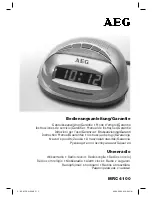
RCIM User’s Guide
3-12
Edge-Triggered Interrupts
1
Each RCIM board has incoming external interrupt lines, called ETIs or edge-triggered
interrupts, so-named after their most common mode of operation. These lines permit users
to provide their own interrupt sources. The RCIM processes and delivers these interrupts
to the host system and, if they are distributed, routes and delivers them to all other RCIMs
in the chain as distributed interrupts. RCIMs can support up to twelve ETIs (0-11).
Each ETI is independently configurable. An ETI may treat the incoming signal as an edge
or level sensitive interrupt. If edge sensitive, it may raise an interrupt on either the rising or
the falling edge. If level sensitive, it may raise interrupts for either the high or the low
signal value. To specify how the incoming signal pattern is converted to interrupt requests,
use one of the ETI configuration options described under “Input Configuration”.
Applications in turn arm or disarm, enable or disable each ETI on each system on the fly
as appropriate to the needs of those applications.
One requirement the RCIM imposes on external signal generating equipment is that the
signals they output must hold any low or high signal value for at least 1 microsecond
before changing to the next state. Pulses of shorter duration may not be recognized by the
interrupt controller. As long as the pulse is longer than 1 microsecond, the duration of the
pulse is not important.
The
rcim_eti(4)
man page provides complete information about ETIs.
Input Configuration
1
Each input (ETI) can be configured to trigger on the rising or falling edge of a signal, or on
a high or low signal value using the
input
configuration option. This option has the
following syntax:
input
N
/
[
rising
|
falling
|
high
|
low
]
The default setting for an input is “falling.”
The flag words (
rising
,
falling
,
high
, l
ow
) can be specified using the first character
of the word. These words are not case sensitive.
For backwards compatibility, the original name
eti
is still accepted.
Examples include:
See the “Configuration” section in Chapter 2 or the
rcim(4)
man page for the various
methods available for specifying configuration options.
input0/falling
sets input 0 to trigger on the falling edge of its input signal
input1/r
sets input 1 to trigger on the rising edge of its input signal
input2/h
sets input 2 to trigger on a high signal value
Summary of Contents for RCIM
Page 1: ...Real Time Clock and Interrupt Module RCIM User s Guide 0898007 1000 March 2021...
Page 10: ...RCIM User s Guide 1 4...
Page 32: ...RCIM User s Guide 2 22...
Page 80: ...RCIM User s Guide A 28...
Page 102: ...RCIM User s Guide C 2...
















































